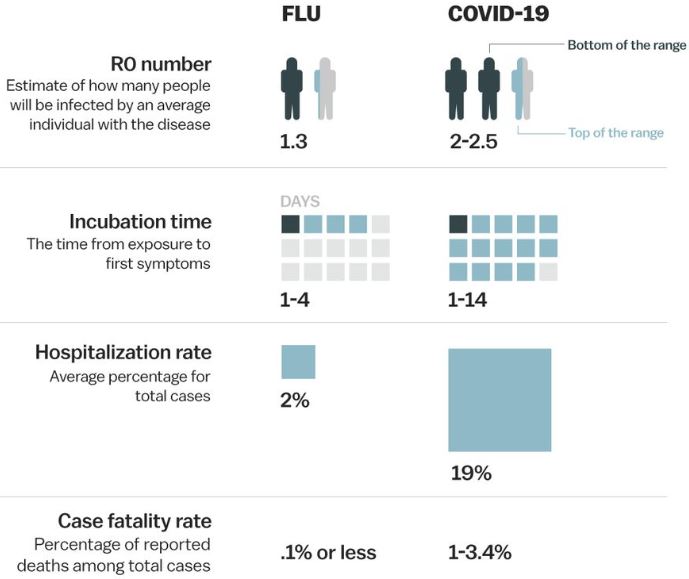 Capital Punishment / Picture Credit: Foundation for Economic Education
Capital Punishment / Picture Credit: Foundation for Economic Education
Introduction
The overall global response to the Coronavirus has been to shut down social life and to work from home until the spread of the virus can be contained. On the basis of experience from China we know this might take as long as 3 months if factories and offices are closed as well. At this point we do not know if the softer versions of the shutdown, whereby production facilities remain open as currently practised by many western countries, will follow the same timeline. Regardless what strategy is applied, the economic damage will be significant and massive government financed support packages are about to be implemented to avoid an economic collapse of our society.
Three months ago, the Coronavirus, also referred to as Covid-19, was not known to science. No human immune system had seen it before, consequently no unexposed human had any natural immunity to it. With symptoms somewhat similar to the seasonal flue, first statistics from China indicate that the Covid-19 is about twice as contagious with at least ten times the fatality rate as shown by the following graph (Supplied by Christina Animashaun/vox.com):

This chart is preliminary, based on information available to mid-March 2020. Due to the lack of testing facilities, especially in the US, there is still considerable uncertainty about the health impact of the virus. What we know so far is that people beyond 65 with a history of lung-problems are more vulnerable and that the high hospitalization rate is quickly reaching the available bed and intensive care-capacity of hospitals reducing the chance for survival.
The deadly threat of Viruses and Microorganisms
Viruses and microorganisms are not a new health threat and have plagued humans with devastating results for centuries. Here are some examples:

Rising global interactions have sparked opportunities for the outbreak of a pandemic. Urbanization in the developing world is bringing more and more rural residents into denser neighbourhoods, increasing the danger that infectious diseases can spread rapidly. Scientists estimate that three out of four new diseases come from animals and that there are at least 80’000 unknown variations of animal viruses that could infect humans. There is wide agreement that the availability of new drugs and vaccinations are the only way to stop the Coronavirus. Until then quarantining infected individuals seems to be the only way to avoid a collapse of our health-care system.
AI in support of battling the Corona Crisis
One of the first instances of relying on geography and statistical analysis occurred in mid-19th century London, during a cholera outbreak. In 1854, Dr. John Snow concluded that cholera was spreading via tainted water and decided to display neighbourhood mortality data directly on a map. This method revealed a cluster of cases around a specific pump from which people were drawing their water. Thanks to mobile internet-connectivity we now have huge amounts of data available to monitor the spread of the disease based on an individual’s positioning data (GPS) and their movements and interactions with others. Monitoring health information such as body temperature or heart rate provide further information about the spread of the virus. Machine learning’s ability to interpret large amounts of data at unprecedented computational efficiency and speed enables health and government officials to make better decisions throughout the entire evolution of an outbreak. Applying AI, the process of battling an outbreak more effectively can be summarized as follows:
- Prediction
Researchers use AI and machine learning to help predict hotspots where new diseases could emerge. The technology can integrate data about known viruses, animal populations, human demographics and cultural/social practices around the world to predict outbreaks. Government and public-health officials can use this data to be proactive and take steps to prevent these kinds of outbreaks – or at minimum, do a better job preparing for them.
- Detection
When previously unknown viruses infect humans, time becomes a precious resource. The quicker a disease outbreak is detected the sooner action can be taken to stop the spread and effectively treat the infected population. AI and machine learning improve the speed of detection – weeks before traditional disease reporting would indicate the potential threat of an outbreak.
- Response
AI can integrate travel-, population- and disease-data to predict where and how quickly a disease might spread. In addition to using AI to predict the spread of a disease, it can improve the application of current treatment and accelerate the time it takes to develop new treatments. Creating vaccines for newly discovered viruses is still a difficult and time-consuming process. AI-driven drug discovery will drastically reduce the amount of time and money required to develop new life-saving medications.
With thousands of researchers working around the globe to find a cure, every day counts to save lives and reduce the damage to our economy. As organizations and governments around the world ask their citizens to practice social distancing to reduce the rate of infection, internet-connectivity is allowing people to maintain connections and commerce like never before. However, the strain on family life, with most members locked-up in homes too small for home-office activities, will eventually cause frustration and lead to aggression.
How to get back to ‘normal’
It took just one month for the virus to cause a global pandemic and a shutdown of economic activities at a time when digital transformation and its integration with AI was in full swing, accelerating the relentless drive to improve productivity with intelligent tools. A booming stock-market providing huge sums of venture capital and causing massive disruptions to many traditional -business segments has come to a sudden halt. Mobility and internet-connectivity had fostered globalization at an accelerating rate while the urge to take part in events and/or travel to far-distant resorts for leisure has spurred air-travel and tourism to new highs. Economic reality will come as a brutal corrector. Tourism and travel will be the first to be hit. The reduction in venture capital will force many not yet profitable start-ups into bankruptcy. It will take years to recover from the economic downturn and return to a stable economy.
What we are also experiencing however, is the emergence of solidarity in support of those that are most threatened by the virus, a trend which is likely to enhance the application of collective intelligence and sociality against the widespread individualism/egoism that has marked our western society since WW2. While research budgets are likely to be cut due to financial concerns, the human drive to explore new frontiers will prevail and eventually pick-up the tracks left when the pandemic caused a full stop. This said, the acceleration of innovation and knowledge generation will continue with the result that life-long-learning and the segmentation of our population in 30+, 50+ and 70+ segments will refuel the discussions about employment, fairness and guaranteed income. Some of us might have the option to rethink our values and possibly discover our inner-self as a resource for a successful work-life balance. For the large bulk of the population, however, to get back to ‘normal’ is foremost an existential issue which offers little freedom for change. Maslow’s ‘Hierarchy of Needs’ will continue to influence and motivate our behavior, mastering existential issues as a first essential step towards higher-level satisfaction and self-fulfillment.
Lessons learned
Preventing future pandemics adds a new dimension to the use of science and technology calling for swift guidance and action in protecting human life. We have the means to uncover the start of a pandemic like never possible before. Personal tracking data (GPS) coupled with body sensor information (body temperature, heart rate, brain activity etc.) provide potential disease-status-information in real-time which can be processed by powerful service centers. Conversely the simulation of potential virus structures coupled with AI supported drug design will provide the means to find a cure and vaccine against a new virus. What used to take years can now be done within a few months while the need for clinical testing remains the biggest bottleneck. While the emerging application of virtual and augmented reality will support our efforts to reduce travel and facilitate the implementation of collective intelligence, to experience true human interaction will remain vital to human’s psychological wellbeing. While the threat and fear of a new pandemic will give mass- and event-tourism a possibly lasting blow, the value of the local community as a resource of emotional well-being, knowledge exchange and social solidarity will reset our mindset of globalization as expressed by the statement:
Think global – Act local
Personal communication without social distancing and isolation will reemphasize the values associated with this mindset. Experiencing virtuality will increase our desire for reality. To follow this path, however, requires trust towards our democratic institutions, balancing freedom and responsibility towards a common goal.
The real problem ahead: Machine Viruses and Cybercrime
While the chances that we eventually can reduce or better deal with pandemics seem good, a fundamental requirement to achieve progress is access to massive amounts of personal data in real-time such as location or body-sensing information. The existing threat of machine viruses, personal data theft, extortion with ransomware or the distribution of fake-information is likely to pose a threat as serious as global pandemics. While billions of dollars are spent to protect our physical health, a small number of super-intelligent criminals can destabilize our society. A lot has been done to add protective measures to personal data such as the EC’s General Data Protection Regulation (GDPR). What is missing however, is a global legal framework to punish those responsible for these criminal acts. Some of these units operate under the protection of secret government agencies as the line between cyberterrorism and cyberwarfare has thinned. A binding UN resolution against cybercrime, possibly similar to the Treaty on the Non-Proliferation of Nuclear Weapons (NPT) is needed. The NPT is a landmark international treaty whose objective is to prevent the spread of nuclear weapons and weapons technology and to promote cooperation in the peaceful uses of nuclear energy and to further the goal of achieving nuclear disarmament and general and complete disarmament. While retaliation might be the most effective deterrent against the outbreak of a nuclear war, cybercrime is enacted by individuals taking advantage of flaws in the design of hardware and software and its internet-connectivity. The threat of punishment and imprisonment seems to be the only way to reduce the threat of cybercrime. This global problem requires a global solution.
Conclusion
Today’s research activities are unthinkable without internet-connectivity. While virtuality and collective intelligence enhance knowledge generation, recognizing the value of reality and personal interactivity redefines our mindset of globality. The dependency on internet-connectivity as a fundamental resource for many activities in our day-to-day lives has increased our vulnerability to machine induced viruses. While biotechnology stands a good chance to keep future pandemics in check, punishment and imprisonment of cyber-criminals is a must to assure future prosperity and human wellbeing.
Hello Peter,
much appreciate your excellent analysis and considerations on far reaching also future impact , which is dramatic.
In respect to cyber-crime and your sentence: ‘This global problem requires a global solution’.
Clearly, yes. The ongoing pandemic mitigation efforts and fear may on one hand better the global conscience and law governance but on the other hand, as you highlight, increase the risks on cyber-crime via new surfaces (data-sets, applications). The already published, shared data on COVID-19 allow phishing crimes to fine-target the most exposed persons via the already used social engineering tools. Also, since this week EU mobile operators share users location data with government. I hope the data sets won’t leak.
Having family, friends in different countries confined I put the frequently used COVID-19 bookmarks on https://noulloc.com/
In this disturbing times your writing is especially valuable and also helpful
Many thanks and take care.